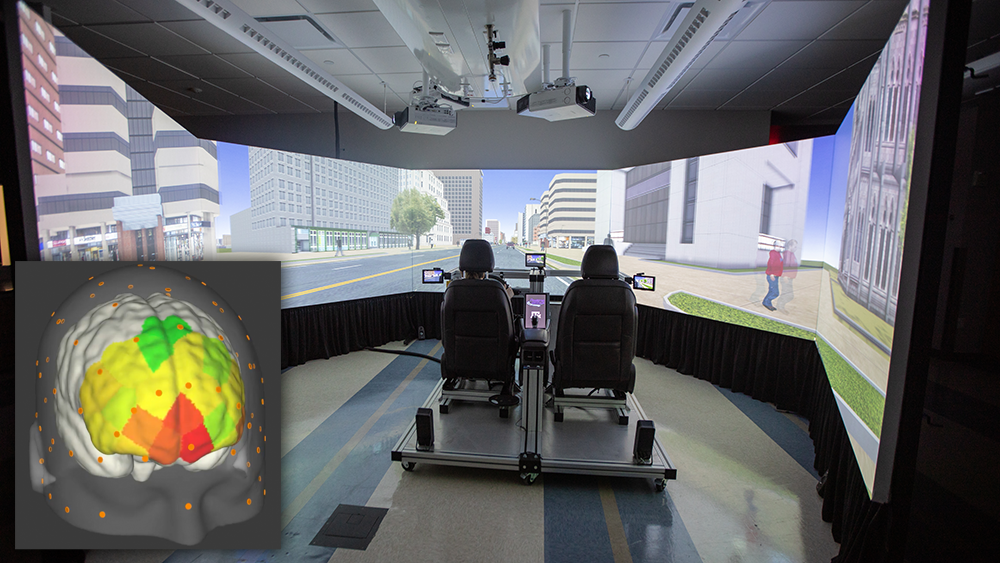
The research team will use brain imaging to examine how calibration models influence dynamic trust and driving behavior. |
Image: Texas A&M Engineering
Automated vehicle (AV) technology is widely acknowledged as a promising means to prevent crashes, increase mobility among drivers and even lower emissions. But, there is a hesitancy toward autonomy among drivers, which Texas A&M University researchers are attempting to understand.
Dr. Anthony McDonald, assistant professor, and Dr. Ranjana Mehta, associate professor in the Wm Michael Barnes ’64 Department of Industrial and Systems Engineering, utilize neuroergonomics to measure and model human driver trust in automated vehicles. The team has been awarded a grant for this research by the National Science Foundation.
“One of the unique things about this project is that it’s focused on dynamic trust between humans and a machine, or humans and an automated vehicle in this case,” McDonald said. “Some people are more predisposed to trust automation and systems than others. Our hypothesis is that trust among these people differs over time after interactions with the automation and our goal is to measure those changes objectively.”
Neuroergonomics is the study of the brain and behavior at work and is the pillar for driver trust measurements with autonomous vehicles. More specifically, the research team will use brain imaging, and model trust and driver behavior to examine how trust calibration models influence dynamic trust and driving behavior.
The team will conduct two experiments using the driving simulator in industrial and systems engineering to gather driver behavior data and subjective, neural and physiological trust measures to understand how particular regions of the brain communicate with each other or don’t when a driver wagers trust. The first year of this three-year project will begin with data collection on 60-100 participants.
“We will then be able to see how trust builds over time and capture it using brain signals,” Mehta said. “In the simulator, we can also breach driver trust in the automated vehicle by having the simulator’s automation fail to overtake another vehicle in the manner expected. We are interested to see how similar or different human-automation trust and its neural correlates are in the automated vehicle application space.”
The research team will be able to map communication, or lack thereof, between different regions of the brain as trust in the AV is built, broken and repaired over the course of the experiment among drivers who vary in their levels of trust in automation.
These neural markers can be employed to develop trust detection models that can trigger trust calibration methods to ultimately increase the transparency of the vehicle’s reliability so that the driver can see and calibrate how much control they want to retain while driving.
“Our goal is to make substantial progress in our understanding of dynamic trust, laying the groundwork for measuring and modeling it,” McDonald said. “We want to produce fundamental contributions that ultimately lead to safer vehicle technology.”
Dr. Anthony McDonald, assistant professor, and Dr. Ranjana Mehta, associate professor in the Wm Michael Barnes ’64 Department of Industrial and Systems Engineering, utilize neuroergonomics to measure and model human driver trust in automated vehicles. The team has been awarded a grant for this research by the National Science Foundation.
“One of the unique things about this project is that it’s focused on dynamic trust between humans and a machine, or humans and an automated vehicle in this case,” McDonald said. “Some people are more predisposed to trust automation and systems than others. Our hypothesis is that trust among these people differs over time after interactions with the automation and our goal is to measure those changes objectively.”
Neuroergonomics is the study of the brain and behavior at work and is the pillar for driver trust measurements with autonomous vehicles. More specifically, the research team will use brain imaging, and model trust and driver behavior to examine how trust calibration models influence dynamic trust and driving behavior.
The team will conduct two experiments using the driving simulator in industrial and systems engineering to gather driver behavior data and subjective, neural and physiological trust measures to understand how particular regions of the brain communicate with each other or don’t when a driver wagers trust. The first year of this three-year project will begin with data collection on 60-100 participants.
“We will then be able to see how trust builds over time and capture it using brain signals,” Mehta said. “In the simulator, we can also breach driver trust in the automated vehicle by having the simulator’s automation fail to overtake another vehicle in the manner expected. We are interested to see how similar or different human-automation trust and its neural correlates are in the automated vehicle application space.”
The research team will be able to map communication, or lack thereof, between different regions of the brain as trust in the AV is built, broken and repaired over the course of the experiment among drivers who vary in their levels of trust in automation.
These neural markers can be employed to develop trust detection models that can trigger trust calibration methods to ultimately increase the transparency of the vehicle’s reliability so that the driver can see and calibrate how much control they want to retain while driving.
“Our goal is to make substantial progress in our understanding of dynamic trust, laying the groundwork for measuring and modeling it,” McDonald said. “We want to produce fundamental contributions that ultimately lead to safer vehicle technology.”